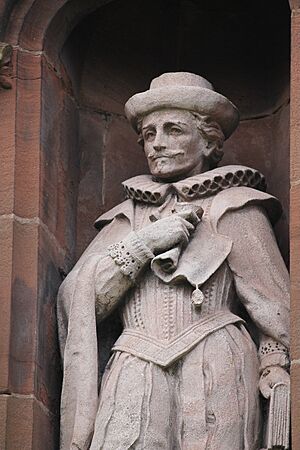William Salesbury facts for kids
William Salesbury (around 1520 – around 1584) was a very important Welsh scholar during the Renaissance. He is best known for being the main person who translated the New Testament into Welsh in 1567. This was a huge step for the Welsh language and for people in Wales to read the Bible.
Contents
Salesbury's Early Life
William Salesbury was born around 1520 in a place called Llansannan in Conwy, Wales. He was the second son of Ffwg Salesbury and Annes. By 1540, he had moved to Plas Isa in Llanrwst.
He likely went to school nearby before studying at Oxford University. At Oxford, he learned Hebrew, Greek, and Latin. He also learned about new ideas from people like Martin Luther and William Tyndale. These ideas were part of the Renaissance, a time of new learning and discoveries. It was probably at Oxford that Salesbury became a Protestant.
Even though he spent a lot of time in London, there is no sign he traveled outside of Britain. His wife was Catrin Llwyd. She passed away around 1572.
Salesbury's Career and Writings
William Salesbury was a very busy writer and translator. He wanted Welsh people to be able to read the Bible and learn new things in their own language.
First Welsh Dictionary
In 1547, Salesbury created an English-Welsh dictionary called A dictionary in Englyshe and Welshe. This might have been the very first book ever printed in Welsh! It helped people learn both languages.
Books on Language and Science
In 1550, he published a book that taught people how to pronounce Welsh letters. This book is still important today for understanding how English was spoken back then. Salesbury also wrote a science book in 1550 called The Descripcion of the Sphere or Frame of the Worlde. Some people say this was the first science book written in English.
He also published books in Welsh. In 1547, he put together a collection of 930 Welsh proverbs. These were wise sayings gathered by another scholar named Gruffudd Hiraethog.
Religious Writings
Salesbury was a strong Protestant. He believed that priests should be allowed to marry. In 1550, he published a book in both Welsh and English to argue this point. He used old Welsh laws to show that priests could marry a long time ago. This was important because the royal family at the time, the Tudors, had Welsh roots.
He also wrote a book against the idea of stone altars in churches, which was a big debate at the time. In 1551, he translated parts of the 1549 Book of Common Prayer into Welsh. This was his first big step towards bringing the Bible into the Welsh language.
Hiding During Mary I's Reign
When Queen Mary I ruled (1553–1558), she was a Catholic. Because Salesbury was a Protestant, he had to hide during her reign. This meant he stopped writing and publishing books for a while.
Translating the New Testament
Salesbury strongly believed that everyone should have the Bible in their own language. He wrote, "Insist on having Holy Scripture in your language." When Queen Elizabeth I became queen, Salesbury could finally work on this big project.
In 1563, a law was passed saying that a Welsh translation of the Bible and the Book of Common Prayer had to be ready by March 1, 1567. Salesbury worked with Bishop Richard Davies and Thomas Huet to translate the New Testament from the original Greek into Welsh. Salesbury did most of the translation and was also the editor.
The Welsh New Testament was published on October 7, 1567. Some people found Salesbury's translation a bit hard to understand because it used some Latin words and unusual spellings. However, it was still a great translation. In fact, Bishop William Morgan later used much of Salesbury's New Testament in his own Welsh Bible in 1588.
Salesbury also translated the English Book of Common Prayer into Welsh. This was published in 1567 as Y Llyfr Gweddi Gyffredin.
Last Known Work
Salesbury's last known work was a book about plants called Llysieulyfr (meaning 'Herbal'). It was based on other famous plant books of the time. It usually listed the plant's name in Latin, English, and Welsh, described it, said where it grew, when it appeared, and what it was used for.
Salesbury's Death and Legacy
William Salesbury likely died around 1580, but we don't know where he was buried. He is remembered as an amazing Welsh scholar from the Renaissance. He was curious and interested in many different subjects. Many people believe he did a great service to the Welsh nation. His translations of the Bible into Welsh helped create the foundation for modern Welsh writing.
See also


